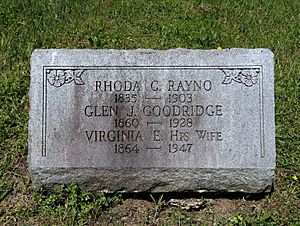Glenalvin Goodridge facts for kids
Quick facts for kids
Glenalvin Goodridge
|
|
|---|---|
| Born | 1829 York, Pennsylvania, U.S.
|
| Died | November 14, 1867 (aged 37–38) Minneapolis, Minnesota, U.S.
|
| Resting place | Minneapolis Pioneers and Soldiers Memorial Cemetery |
| Occupation | Photographer, teacher |
| Spouse(s) |
Rhoda Cornelia Grey
(m. 1851) |
| Parent(s) |
|
Glenalvin J. Goodridge (born in 1829 – died November 14, 1867) was an American photographer. He was one of the very first African-American photographers in the United States.
Contents
A Pioneer Photographer
Glenalvin J. Goodridge was born in York, Pennsylvania, in 1829. He was the first son of William C. Goodridge. His father was a formerly enslaved person who became a successful businessman.
Early Life and Education
From 1847 to 1851, Glenalvin Goodridge worked mainly as a teacher. He taught at the "Colored High School" in York. He continued teaching part-time after that. A famous anti-slavery activist, Frances Ellen Watkins Harper, also taught at the same school starting in 1864.
Family Life
Glenalvin Goodridge married Rhoda Cornelia Grey on June 10, 1851. Their son, Glen J. Goodridge, was born in 1860.
Opening a Photo Studio
Glenalvin Goodridge became a photographer. He opened a photo studio with his brothers, Wallace Goodridge and William O. Goodridge. Their first studio was in York, Pennsylvania. Later, they opened another studio in East Saginaw, Michigan. Wallace closed the Saginaw studio in 1922.

Later Years and Passing
Glenalvin Goodridge passed away on November 14, 1867. He died from tuberculosis in Minneapolis, Minnesota. He is buried at the Minneapolis Pioneers and Soldiers Memorial Cemetery.
Lasting Legacy
Glenalvin Goodridge left an important mark on history. In 2018, a special reproduction of his photo studio opened. It is part of the Goodridge Freedom Center in York, Pennsylvania. This center helps people learn about his family's history.
In 2021, many of his early photographs, called daguerreotypes, were acquired. They became part of the collection at the Smithsonian American Art Museum. This shows how important his work was.

